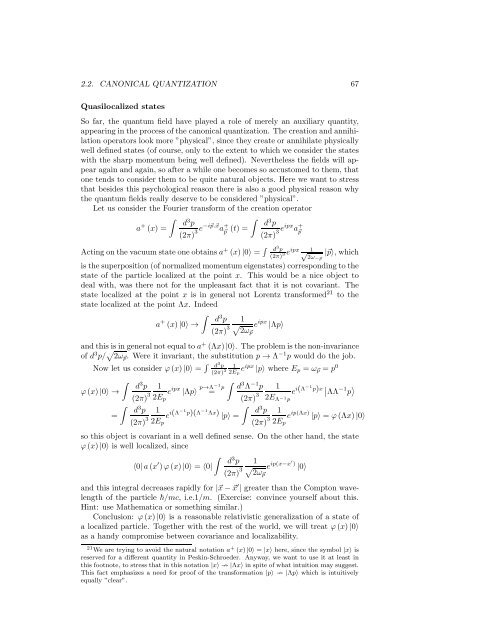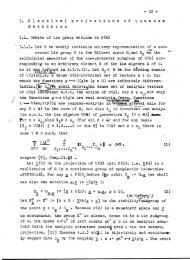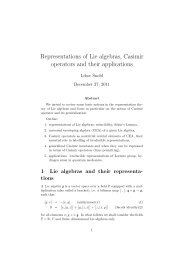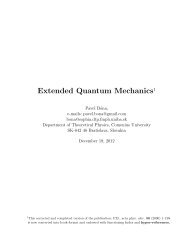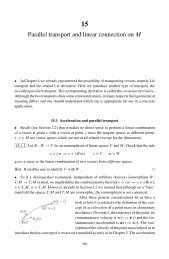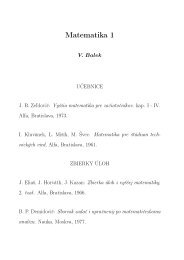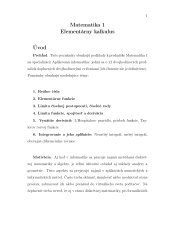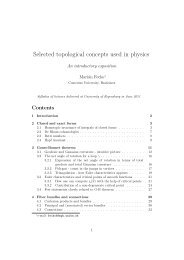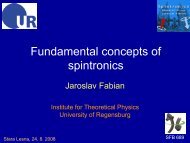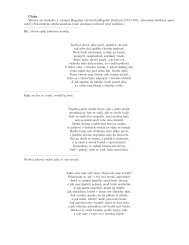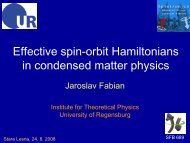Quantum Field Theory I
Quantum Field Theory I
Quantum Field Theory I
You also want an ePaper? Increase the reach of your titles
YUMPU automatically turns print PDFs into web optimized ePapers that Google loves.
2.2. CANONICAL QUANTIZATION 67<br />
Quasilocalized states<br />
So far, the quantum field have played a role of merely an auxiliary quantity,<br />
appearingin the processofthe canonicalquantization. The creationand annihilation<br />
operators look more ”physical”, since they create or annihilate physically<br />
well defined states (of course, only to the extent to which we consider the states<br />
with the sharp momentum being well defined). Nevertheless the fields will appear<br />
again and again, so after a while one becomes so accustomed to them, that<br />
one tends to consider them to be quite natural objects. Here we want to stress<br />
that besides this psychological reason there is also a good physical reason why<br />
the quantum fields really deserve to be considered ”physical”.<br />
Let us consider the Fourier transform of the creation operator<br />
∫<br />
a + d 3 ∫<br />
p<br />
(x) =<br />
(2π) 3e−i⃗p.⃗x a + ⃗p (t) = d 3 p<br />
(2π) 3eipx a + ⃗p<br />
Actingonthevacuumstateoneobtainsa + (x)|0〉 = ∫ d 3 p<br />
e ipx √ 1 |⃗p〉, which<br />
(2π) 3 2ω−⃗p<br />
is thesuperposition(ofnormalizedmomentumeigenstates)correspondingtothe<br />
state of the particle localized at the point x. This would be a nice object to<br />
deal with, was there not for the unpleasant fact that it is not covariant. The<br />
state localized at the point x is in general not Lorentz transformed 21 to the<br />
state localized at the point Λx. Indeed<br />
∫<br />
a + (x)|0〉 →<br />
d 3 p 1<br />
(2π) 3 √ e ipx |Λp〉<br />
2ω⃗p<br />
andthis isingeneralnotequaltoa + (Λx)|0〉. Theproblemisthe non-invariance<br />
of d 3 p/ √ 2ω ⃗p . Were it invariant, the substitution p → Λ −1 p would do the job.<br />
Now let us consider ϕ(x)|0〉 = ∫ d 3 p 1<br />
(2π) 3 2E p<br />
e ipx |p〉 where E p = ω ⃗p = p 0<br />
∫<br />
ϕ(x)|0〉 →<br />
∫<br />
=<br />
d 3 ∫<br />
p 1<br />
(2π) 3 e ipx |Λp〉 p→Λ−1 p d 3 Λ −1 p 1<br />
=<br />
2E p (2π) 3 e ∣ i(Λ−1 p)x ΛΛ −1 p 〉<br />
2E Λ −1 p<br />
d 3 p<br />
(2π) 3 1<br />
2E p<br />
e i(Λ−1 p)(Λ −1 Λx) |p〉 =<br />
∫<br />
d 3 p 1<br />
(2π) 3 e ip(Λx) |p〉 = ϕ(Λx)|0〉<br />
2E p<br />
so this object is covariant in a well defined sense. On the other hand, the state<br />
ϕ(x)|0〉 is well localized, since<br />
∫<br />
〈0|a(x ′ d 3 p 1<br />
)ϕ(x)|0〉 = 〈0|<br />
(2π) 3 √ e ip(x−x′) |0〉<br />
2ω⃗p<br />
and this integral decreases rapidly for |⃗x−⃗x ′ | greater than the Compton wavelength<br />
of the particle /mc, i.e.1/m. (Exercise: convince yourself about this.<br />
Hint: use Mathematica or something similar.)<br />
Conclusion: ϕ(x)|0〉 is a reasonable relativistic generalization of a state of<br />
a localized particle. Together with the rest of the world, we will treat ϕ(x)|0〉<br />
as a handy compromise between covariance and localizability.<br />
21 We are trying to avoid the natural notation a + (x)|0〉 = |x〉 here, since the symbol |x〉 is<br />
reserved for a different quantity in Peskin-Schroeder. Anyway, we want to use it at least in<br />
this footnote, to stress that in this notation |x〉 ↛ |Λx〉 in spite of what intuition may suggest.<br />
This fact emphasizes a need for proof of the transformation |p〉 ↛ |Λp〉 which is intuitively<br />
equally ”clear”.


